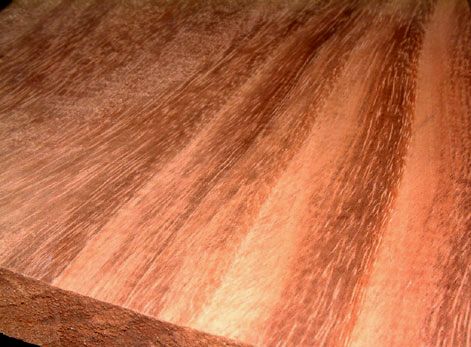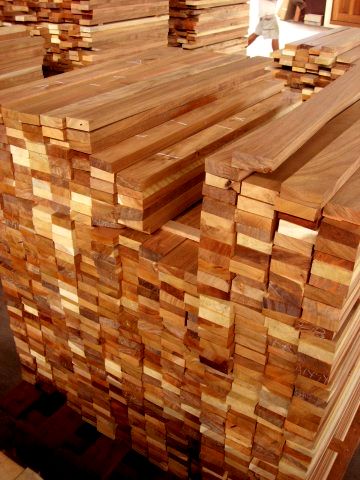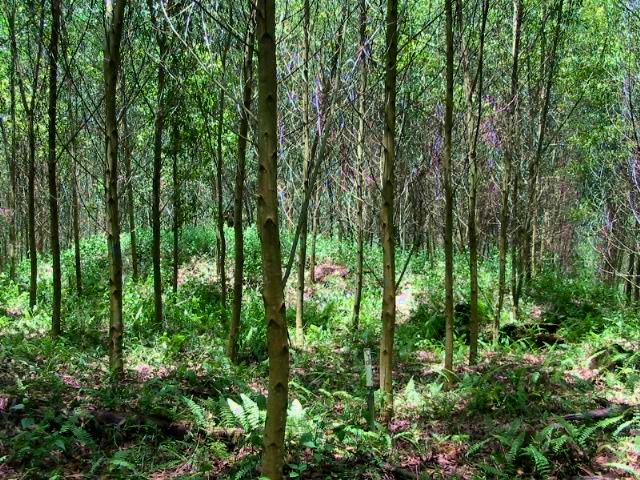
Teak Like Acacia Hardwood
Acacia (species: Acacia Mangium)
Wild Family: Leguminous-Fabaceae
Common name: acacia, mangium
Commercial name: black wattle, mange
Acacia hardwood of the family of hardwoods with similar properties as Teak. Acacia mangium is an important multipurpose tree for the tropic lowlands. Mangium is one of the major fast-growing species used in plantation forestry programs throughout Asia, the Pacific, and the humid tropics. It has naturalized in Puerto Rico, Brazil, and many other areas. Due to its rapid growth and tolerance of very poor soils, A. mangium is playing an increasingly important role in efforts to sustain a commercial supply of tree products while reducing pressure on natural forest ecosystems.
Mangium (Acacia mangium) wood is hard, with a basic specific gravity of 0.65 to 0.69. It produces a wood that is useful for a variety of purposes. The sapwood is cream colored and the heartwood is ash dark brown-yellowish (Francis J., 2002)[1] or pale brown with a pinkish tinge and is not sharply demarcated from the sapwood.
Acacia Hardwood

This timber is good for furniture, cabinets, turnery, and floors. It is also suitable for particleboard, plywood, veneer, pulp, fence posts, firewood, and charcoal. Nontimber uses include honey production, adhesives, and as an ornamental and shade tree for roadsides or other urban forestry uses. The leaves can be used as livestock fodder (Francis J., 2002).[2]
Mangium’s grain is commonly interlocked, with medium luster; its texture is moderately fine and uniform; it is without distinctive odor or taste. The Janka side hardness test shows 1,280 lb for green material and 1,750 lb at 12 percent moisture content (windsorplywood.com)[3]. Wood drying occurs at moderate speed, and slight drying defects could take place, such as cracking at the ends or small lateral cracks. It is reported to be moderately resistant to preservative treatments (FACT-Net)[4].
Acacia Lumber

No data is available about working properties or machining characteristics, but tests in Australia indicate its suitability for cutting into veneer.
Acacia mangium is native to Australia; Indonesia; and Papua, New Guinea, but now has a wider latitudinal and longitudinal range. Introduced in Costa Rica, Bangladesh, Cameroon, Puerto Rico, Hawaii, Malaysia, Nepal, and the Philippines, Acacia mangium is a low-elevation species associated with rain forest margins and disturbed, well-drained acid soils (pH 4.5–6.5). Altitudinal range is from sea level to more than 100 meters (328 feet), with an upper limit of 780 meters (2560 feet). It is typically found in the humid, tropical lowland climatic zone characterized by a short dry season and a mean annual rainfall between 1500 to 3000 mm (59 to 118 in.). Acacia mangium can tolerate a minimum annual rainfall of 1000 mm (39.4 in.). Mean monthly temperatures tolerated range from a low of 13 to 21ºC (55–70 ºF) to a high of 25 to 32ºC (77–90ºF). Though considered an evergreen species, A. mangium does not grow continuously throughout the year; growth seems to slow or cease in response to the combination of low rainfall and cool temperatures (winrock.org).[6]
It is a tree up to 30 m (98.4 feet) in height, and the diameter rarely exceeds 50 cm (20 in.) DBH. The trunk can be unbranched for more than half of the total tree height; it is sometimes fluted at the base. The bark is rough and furrowed, either grey or brown. The dark green, glabrous (lacking hair) leaves are large, up to 25 cm (9.8 in.) long, 3 to 10 cm (1.2–3.94 in.) broad, normally with four main longitudinal nerves; on juvenile trees the leaves are compound. The flowers have a mild, sweet fragrance; they are white or creamy, in rather loose spikes up to 10 cm (3.94 in.) long, single or in pairs in the upper leaf corners. The seed pods are broad, linear, and irregularly coiled, and the seeds are shiny dark brown to black.
Seeds mature 6 to 7 months after flowering (www.dfsc.dk)[7].
Young Acacia Plantation

Since A. mangium can grow on marginal soils, many farmers choose to plant this species to improve soil fertility of fallowed fields or pastures. Mangium trees with diameters of 7 cm (2.76 in.) are fire resistant, so in plantations they can be used as fire breaks. This species has been grown in plantations in Costa Rica since 1979 when CATIE (Tropical Agriculture Research and Higher Education Center) introduced the species with a research proposal, and a medium to fast growth is reported with 3.5 m average height growth and 5.4 cm average diameter growth per year. Usually the species branches out, so pruning is essential at an early stage (Coseforma).[8]
Acacia plantation forests have increasingly played an important role in Indonesia and other South East Asian countries to supply wood material for pulp and paper industries. PT. Musi Hutan Persada located in South Sumatra, Indonesia, began to establish its Acacia plantations in 1990 on unproductive sites formerly dominated by alang-alang (Imperata cylindrica) grasslands. A total of approximately 200,000 ha have been planted mainly with Acacia mangium. The species is selected due to its good characteristics; it is adapted to and grows well on inherently acid and poor soils dominating the company's plantation sites. Its wood is excellent for pulp and paper as well as furniture. While the importance of using genetically improved seed has been highly recognized by the company, the first-rotation plantations were established using unimproved local seed due to unavailability of a large amount of improved seed during this period. The better quality seeds have subsequently become available from the tree improvement program set up by the company. The combined use of improved seed with proper silvicultural practices has been employed with the objective of having high plantation productivity.
The first rotation plantation began to be harvested in 1999; the productivity of this plantation is around 190 m3 of commercial wood (diameter > 8 cm) at 8 years of age. Due to the concern of long-term sustainability of the plantation, an organized felling system has been adopted with one of the objectives of minimizing soil disturbance. In this system felling and stemwood processing are done manually using chainsaw, while wood extraction is carried out using forwarders, which skid on top of the pile of harvest residues. For the second-rotation plantations, proper silvicultural practices have been adopted, including the use of improved seeds, minimum soil disturbance, conservation of organic matter during harvesting and site preparation, nutrient management, and weed control. It is recognized that the long-term sustainability of a plantation is also dependent upon the socio-economic conditions of the surrounding population. In addition to providing working opportunities for local people, the company has adopted partnership schemes with local communities to grow Acacia plantations with mutual benefit for the communities and company. Acacia plantation is quite recent in Indonesia, and controversial issues regarding this matter are oftentimes raised, including allelopathy, biodiversity, nutrient drain and growth decline. While some of these issues are worth serious attention, various efforts to maintain sustained productivity of plantation should be addressed. The Acacia plantation at PT. Musi Hutan Persada has shown the ability to improve degraded land, have reasonable productivity, generate job and economic opportunities for local communities. In this regard Acacia plantations could provide a good model for the rehabilitation of many unproductive lands and degraded forest in many parts of Indonesia. The capital generated from Acacia plantations could then be used to establish plantations of desired species.
references:
(1) Francis, John K., in Tropical Trees Seed Manual, USDA Forest Service, Agriculture Handbook 721, October 2002. 256-257.
(2) http://www.windsorplywood.com/tropical_woods/blackwattle.html
(3) A publication of the Forest, Farm, & Community Tree Network (FACT Net) (formerly the Nitrogen Fixing Tree Association).
(4) www.winrock.org/forestry/factnet.htm
(5) http://www.dfsc.dk/pdf/Seedleaflets/Acaciamangium_int.pdf.
(6) Proyecto Coseforma, 1996. “Consideraciones sobre Acacia mangium y resultados obtenidos en parcelas establecidas.” Zona Norte, Costa Rica.
(7) Forest Ecology and Management
(8) Integrated Taxonomic Information System
(9) Food and Agriculture Organization of the United Nations